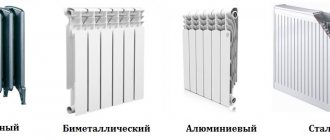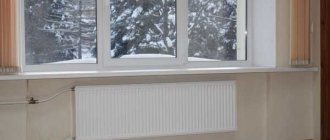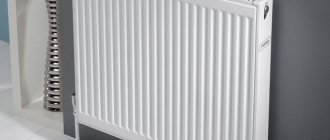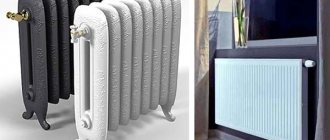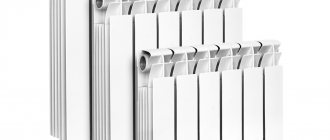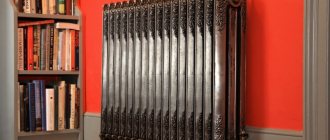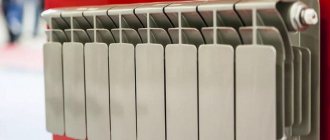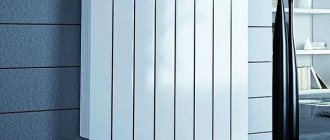Durability characteristics of heating radiators:
| Radiator type | Resistance to internal corrosion | Water hammer resistance | Average service life |
| Steel radiators | Weak | Weak durability | 15-20 years |
| Cast iron radiators | High | Medium durability | 25-35 years |
| Aluminum radiators | High | Medium durability | 20-25 years |
| Bimetallic | High | High durability | 25-30 years |
The service life and reliability of the heating radiator are among the main factors that must be taken into account when choosing heating devices. Therefore, when choosing devices to equip your heating system, you definitely need to find out how long radiators of a certain type last and what factors their durability depends on.
The average service life for radiators of various types, manufactured in accordance with GOST, is given in the table. However, their actual shelf life depends largely on the characteristics of the heating system and operating conditions.
The main external factors that affect the service life of heating radiators are:
- operating pressure of the coolant in the system;
- chemical composition of the coolant;
- coolant temperature in the system.
Also, the durability of radiators installed in apartments in apartment buildings can be greatly affected by water hammer, which occurs when the central heating system is started in the autumn.
Each of the metals from which heating devices are made has a varying degree of resistance to negative factors. Therefore, their durability and reliability indicators will be different.
Radiator service life
When installing new heating systems or upgrading old ones, the correct choice of radiators is of no small importance, the reliability of which can become a determining parameter for the durability of the entire system.
Therefore, the service life of heating radiators is indicated by manufacturers in the accompanying documentation and on the packaging . For various types of devices, subject to correct selection and installation, it is:
| Radiator type | Life time |
| Aluminum | 20–25 years |
| Bimetallic | 25–30 years |
| Steel | 15–20 years |
| Cast iron | 25–35 years |
Factors that determine the service life of heating radiators
- operating pressure in the heating system;
- test pressure;
- chemical purity of the coolant;
- coolant temperature.
The operating pressure is determined by the type of heating system, and for private houses it is usually 3–5 atmospheres, and for multi-storey houses 8–16 atmospheres. The operating pressure of the radiator, guaranteed by the manufacturer, must be at least 2 atmospheres higher than the operating pressure in the system.
The same variety applies to coolants: antifreeze solutions can be used in cottages, and in centralized heating, water usually undergoes chemical treatment.
Another danger to the functioning of radiators lies during the seasonal start-up of heating systems, when water hammer occurs, and not all materials and structures are able to successfully withstand it.
Therefore, when choosing, it is necessary to take into account the susceptibility of the radiator material to negative influences. For example, cast iron is an inert, brittle metal, steel quickly corrodes at welding points, and aluminum is destroyed by high acidity of water.
Features of cast iron and steel radiators
These properties of metals explain the fact that classic cast iron radiators are insensitive to water quality, but very sensitive to water hammer and system pressure exceeding 9 atmospheres.
Steel radiators quickly fail in the presence of oxygen in the water and when the operating pressure in the system exceeds the standard for these batteries (8–10 atmospheres). Therefore, they only work reliably in autonomous heating systems.
Reliability of bimetallic radiators
All the advantages of aluminum radiators, but without their disadvantages, are embodied by the developers in bimetallic radiators.
The strength and durability of these products is ensured by the use of steel collector pipes for contact with the coolant, which significantly reduces the destructive effects of water.
The optimal combination of steel strength and aluminum thermal conductivity allows us to guarantee a service life of bimetallic radiators of 25 years at the highest operating pressure for such devices (up to 24 atmospheres), that is, this is the optimal choice for multi-story construction.
The maximum service life of heating batteries is ensured not only by the high quality of their manufacture, but also by taking into account, when choosing them, all the features (working pressure, water treatment, etc.) of heating systems in private or multi-storey construction.
Characteristics and features of cast iron material
Few people know that the very first cast iron radiator is now much more than 100 years old. What he has not experienced are revolutions and wars. However, despite this, it still successfully performs its functions.
Cast iron heating radiators are manufactured using the casting method. The characteristics that define the particularity of a cast iron alloy relate to its homogeneity. Cast iron radiators are used for both centralized and autonomous heating.
What are the advantages of cast iron heating systems?
The figure shows a heating battery made of cast iron.
Anti-corrosion properties. Cast iron can be classified as a material that practically does not corrode, due to which its service life can reach 50-100 years. Radiators can withstand temperatures up to 50 degrees, so they can even be used in steam heating systems.
Unpretentious to the coolant, that is, its quality. Even the presence of various debris, such as rust or pebbles, does not cause any harm to the battery.
Thick battery walls. These characteristics mainly determine the durability of a cast iron radiator. Cast iron radiators are an ideal option for open-type heating systems, as well as those that empty out after some time. When compared with cast iron radiators, the characteristics of steel ones are significantly inferior, since they will rust in literally 2 years, plus they can also burst at the moment when you least expect it.
Excellent heat storage capacity. After turning off the radiator, even after an hour, its heat transfer is about 30%. As for other batteries, it is usually half as much.
Characteristics of a heating radiator made of cast iron.
The internal cross-section is quite large, which allows you to clean the radiator very rarely.
Characteristics regarding service life. As a rule, manufacturers indicate on cast iron heating radiators a service life of a maximum of 30 years, but in reality the radiator can last much longer (more than 50 years). And if it is filled only with clean water, the service life of cast iron radiators can reach 100 years.
Disadvantages of cast iron batteries:
- Heavy weight. It's no secret that batteries made of cast iron are quite heavy; it is for this indicator that they are inferior to steel, bimetallic and other types of batteries.
- Strength. The pressure that is considered optimal for them is no more than 15 atm, in contrast to the same bimetallic ones, which can withstand all 40.
Dimensions of cast iron batteries and power calculation
Diagram of connecting heating batteries to the system.
As for standard radiators, they have an interaxal distance of about 300-500 mm. However, you can also find taller batteries, for which this value can be 800 mm. The width of the cast iron radiator section, as a rule, ranges from 35 to 60 mm. As for the depth, it can be 92 mm, 99 or 110 mm.
Under normal conditions, the power of a cast iron radiator per 1 sq. m is 120 watts. However, what conditions qualify as such? Rooms with a height of 3 meters, in which there is one window (wooden) and one door, are considered standard. The radiator temperature in this case is 70 degrees.
As the height of the room increases, the power increases accordingly. If PVC windows are installed in the room, then 15% must be subtracted from the amount of power. At a coolant temperature other than 70 degrees, it is necessary to either add or subtract 15% of the power.
Why don't they warm up?
It is extremely unpleasant at the height of the winter season to face the fact that either the whole or part of the heating system is cold. To figure out why the heating radiator in the apartment does not heat, the reasons need to be looked for in what is preventing the flow of coolant into the system.
There are only a few of them:
You can eliminate some of the reasons yourself, for example, remove the air lock.
The heating battery in the apartment has burst - what to do:
- If there is a circulation pump, it must be turned off
to relieve excess pressure on the system. - Open the Mayevsky tap
, and if there is none, then
remove the plugs from the battery
. - These actions will cause air to escape from the system
, which occurs with a characteristic hissing sound. - After water flows from an open tap, turn it off.
It is necessary to prepare containers for the coolant in advance and wait until the whistling from the system stops completely. After some time, you can check the radiators for the presence of heat - if they are hot, then everything is done correctly.
If the reason that the radiators do not heat is a lack of coolant, then such work should not be carried out independently, without having the appropriate experience. When water enters the system, air pockets can form. If the system is clogged, it should also be entrusted to the experts, since this will require removing it for cleaning or completely replacing its damaged areas.
Cast iron heating radiators made in Russia
Cast iron heating radiators made in Russia fully comply with all quality standards accepted in the industry. Technical characteristics allow them to successfully compete with foreign products. The share of cast iron Russian radiators on the heating appliances market is growing every year.
Advantages of cast iron heating batteries
Cast iron heating batteries made in Russia, despite the emergence of modern varieties made from steel, aluminum, copper or alloys, are traditionally in demand among the population. This popularity is explained by a number of their advantages.
- Resistance to working environment. Cast iron practically does not corrode and is less demanding on the degree of purification of the coolant liquid.
- Thickened walls. Give batteries longer service life due to the absence of abrasive wear.
- Increased thermal inertia. Thick cast-iron radiators take a long time to gain temperature, but when the coolant cools down, they warm the room for a long time, releasing the accumulated heat. An important characteristic in a country where power is often cut off, which stops the operation of heating boilers.
- Availability. Of all types of heating equipment, Russian cast iron radiators are the cheapest.
The disadvantages of Russian cast iron batteries include their large mass, which complicates transportation and installation, and their appearance, which is significantly inferior to their foreign counterparts. Modern models are much more resistant to hydraulic shocks, which could damage the previous generation of cast iron batteries (15 - 18 atmospheres).
Russian enterprises producing cast iron heating batteries
The service life of cast iron heating batteries is more than 50 years, so the bulk of the equipment that heats Russian apartments was produced in the Soviet Union, and new enterprises operate on the basis of factories launched during that period. The leaders of domestic manufacturers of cast iron radiators are several factories.
Lyubokhonsky Iron Foundry (Bryansk). A line has been established for the production of batteries MS-140, MS-110, MS-85, with improved design and resistance to pressure drops. Reducing the depth does not lead to a decrease in power; on the contrary, these high-tech models have higher performance than classic ones.
Nizhny Tagil Boiler and Radiator Plant. The main direction is the production of improved MS-140 radiators with non-standard center-to-center dimensions of 300 and 500 mm, with an increased heat transfer coefficient (up to 160 W). The production of a new product has also been mastered - the T-90 battery, of smaller depth and increased decorativeness.
Cheboksary Aggregate Plant. Produces the most popular MS-140, proven over decades, which are found in most old houses. At the same time, the production of more technologically advanced radiator models with three channels and shallower depth has been launched.
The enormous service life of cast iron heating batteries, their reliability and efficiency, coupled with an affordable cost, allow domestic manufacturers to increase production rates to meet increasing demand.
Weight of cast iron battery section
A cast iron battery is considered one of the most profitable devices for heating a home, because in addition to excellent heat transfer, it is highly resistant to corrosion, has a long service life (50 years and older) and is undemanding in terms of the quality of the heat carrier. These factors encourage many people to include it in their individual heating system. At the same time, when creating a heating system, they are forced to take into account its features. One of them is the weight of the cast iron battery.
This indicator is very important because it allows:
- choose the optimal mount;
- choose the right type of battery depending on the design features of the house.
Classic batteries
one section of the most used option weighs 7.12 kg. The total weight of one battery sector is 8.62 kg.
To heat a room of 20 m², you need to install a battery with 12 sections. This means that the weight of an empty heating device will be 85.4 kg, and a radiator with water will be 103.4 kg.
Such a battery must be installed on a mount fixed in the wall. That is, it turns out that the wall must withstand an additional load of almost 104 kilograms. If the wall is built of brick or concrete, then such a cast iron radiator can be safely hung on the wall.
However, if the owner decided to save on building a house and built it from foam concrete, aerated concrete or SIP panels filled with foam, then the classic hanging of a 100-kilogram structure on such walls is a very bad idea.
The classic installation method involves fixing horizontal brackets with hooks at the end to the wall. The latter are equipped with a battery. Walls made of porous materials or SIP panels simply will not withstand high pressure, and the radiator will fall to the floor.
Of course, there is a way out in such a situation. There are even three of them:
- You need to use a special mount, which should be fixed at many points. This is an extra waste of your time and effort. This option is definitely not to the liking of every owner.
- It is necessary to install cast iron batteries of modern modifications. They are lighter and more efficient in terms of heat exchange.
- Choose models that can be installed on the floor.
Modern options for cast iron radiators
consist of lighter sectors. The total mass of the sector is 4.6 kg.
To heat the above room you need to take a radiator with 14 sections. It will weigh 64.4 kg. This figure includes the mass of cast iron and water.
Such a radiator will still be heavy for walls made of porous material, but if you split it into two parts and place them on different walls, then you can forget about the need for additional fastenings.
Domestic manufacturers offer radiators with a lighter sector. Its characteristics are:
- Weight - 3.3 kg
- Volume - 0.6 l.
- Total weight with water - 3.9 kg.
However, they have worse heat transfer. As a result, to heat a room of 20 m² you need to take 22 sections. This means that the mass of the radiator will be 85.8 kg. This weight is not entirely suitable for modern houses made of foam blocks. Radiators with legs can save the situation. The legs have only the first and last sections.
Algorithm for calculating radiator weight
you need to do the following:
- Find out the weight of the section itself.
- Add the weight of water that can fit in the section.
- Analyze the heat transfer and, based on it, determine the required number of sections.
- Multiply the number of sections by the total mass of one sector.
Causes of failure
If the heating system has failed not because of its “antiquity”, then you should look for a fault somewhere else.
It could be:
- The radiator does not match the system of the apartment building.
This may be due to pressure or quality of the coolant. - Flaws when connecting to pipes
, which can cause a breakthrough after a while. - Operating conditions are not suitable for this type of radiator
due to frequent pressure changes. - If the coolant is too littered
, then this causes the accumulation of suspensions at the attachment points, which in due time will lead to a leak. - Gaskets between sections also do not last forever
, and failure of one of them can compromise the integrity of the system.
The main visual sign that something is wrong with the system is an obvious leak, while internal damage, for example, airiness or contamination, can be determined by the temperature in the room.
Technical characteristics of cast iron batteries
Of course, the most important parameters of heating structures are characteristics such as thermal output and power
Manufacturers prescribe power indicators in the technical documentation and, what is important, for a single section
On average, the sectional power of a cast iron heating radiator is 160 W.
The thermal output of cast iron structures is two times worse than that of aluminum or bimetallic ones. However, this disadvantage is due to slight inertia. Cast iron is able to retain thermal energy much longer. These heating structures show themselves most effectively in systems with natural circulation of liquid.
Power of cast iron heating radiators and its comparison with other types of batteries.
| Radiator type | Heat transfer of one section, W | Working pressure, bar | Crimping pressure, bar | Section weight, kg | Section capacity, l |
| Cast iron with a gap between the axes of sections of 500 mm | 160 | 9 | 15 | 7,12 | 1,45 |
| Cast iron with a gap between the axes of sections of 300 mm | 140 | 9 | 15 | 5,4 | 1,1 |
| Bimetallic with a gap between the axes of sections 500 mm | 204 | 20 | 30 | 1,92 | 0,2 |
| Bimetallic with a gap between the axes of sections 350 mm | 136 | 20 | 30 | 1,36 | 0,18 |
| Aluminum with a gap between the axes of sections 500 mm | 183 | 20 | 30 | 0,27 | 0,27 |
| Aluminum with a gap between the axes of sections 350 mm | 139 | 20 | 30 | 1,2 | 0,19 |
Another important parameter is the weight of cast iron heating radiators. One section weighs from 3 to 7 kilograms
The number of sections is different for each model. Much depends on the chosen model, as well as the size of the heated room. After the fasteners for cast iron heating radiators have been installed, sections can be added or removed as desired.
An equally important indicator is the size of the battery. The width of one section is from 8 to 10 cm, the height is from 37 to 57 cm, the depth is from 7 to 12 cm.
The volume of space from the inside can be 0.7-1.5 liters.
It is worth mentioning the working pressure. This is the load exerted by the liquid during circulation through the heating system. Typically the values are 6-10 atmospheres.
Maximum operating pressure. This is the load at which the battery can operate during a period of heavy water impact. When checking the heating system, a load is created inside the lines that is very close to the maximum. New cast iron models can withstand pressure of 12-18 atmospheres.
The average service life of cast iron heating radiators is 30 years. Of course, with careful treatment and favorable conditions, structures can last 60 years. This is a pretty good indicator, which is much higher than that of modern aluminum or bimetal batteries. Such a long service life of cast iron heating radiators is due to the considerable size of the internal channels, which prevents clogging from the inside.
Connection options
The connection of panel heating radiators is divided into side and bottom. The method depends on the design features of the selected device.
Insertion into the circuit using a side connection can be made from the right or left side of the panel. The process itself is not particularly complicated.
Radiators with a bottom connection are most in demand, since it allows you to install a temperature controller.
In addition, in this case the heating pipes can be hidden in the wall. Such radiators are marked “V” and are more expensive.
Types of aluminum radiators
Aluminum batteries differ in manufacturing technology:
You can find out the price and buy heating equipment and related products from us. Write, call and come to one of the stores in your city. Delivery throughout the Russian Federation and CIS countries.
Casting technology
This production method means that each section will be constructed separately. They are cast from silumin (a composition of aluminum and silicon additives). The amount of silicon in this mixture is no more than 12%. This amount is enough to ensure that the device is quite durable and reliable.
The manufacturing process is carried out as follows:
- The mold for casting the battery section consists of two equal parts. Before the composition is poured, both parts are joined under high pressure in a casting unit.
- At the next stage, the finished alloy enters the finished mold through special channels.
- The molten composition spreads through all channels of the mold, where it cools and crystallizes.
- After the crystallization process is completed, the mold must be opened and left until it cools down.
- As soon as the composition has cooled, the neck is welded to the section blanks.
- The next stage: in a special bath, under high pressure, the sections are checked for leaks.
- Then the inner and outer aluminum walls are coated with an anti-corrosion compound, and then they are cooled and dried.
- After the above-described manipulations, the sections are painted using powder enamel.
- At the final stage, the sections are assembled into radiators and are tested for strength and tightness.
This method of manufacturing radiators allows you to create batteries of absolutely any shape.
Extrusion technology
The extrusion process is based on forcing a softened molten metal through a special molding extruder. In this way, a part of the required profile is obtained.
This production method does not imply instant production of radiator parts with a closed volume. Initially, the front and rear parts are formed, which are subsequently connected to each other by thermal pressing.
Using the extrusion method, both individual sections and solid manifolds are manufactured.
The technical indicators of devices made by extrusion are lower than those of batteries made by casting technology. First of all, this is due to a smaller surface area, and therefore lower heat transfer. Another disadvantage is that pressing seams are usually not able to withstand high pressure and quickly begin to rust under the influence of an aggressive coolant environment.
Anodized radiators
Such batteries are made from an alloy in which aluminum has undergone high-quality purification. Its amount in the composition is 90% or more. Both the internal and external surfaces of the product are subjected to anodic oxidation (anodizing).
The standard anodizing process for aluminum radiators is as follows:
- Initially, the batteries are washed well; for this, the radiator is placed in a bath with an alkaline solution and there its surface is cleaned of all kinds of contaminants.
- Then “chemical milling” is carried out. The surface of the aluminum is cleaned of the oxide film, and the thin top layer of metal is also removed.
- The next stage is clarification. Heavy metals are removed from the outside of aluminum.
- Next, the radiators are lowered into a bath of electrolyte; under the influence of this negative charge, an electrochemical reaction occurs, as a result of which a protective oxide film AL203 is formed.
- At the final stage, the layers are compacted by clogging the pores.
To connect all parts of the anodized radiator to each other, external dry couplings are used. Due to this, the inside of the batteries remains smooth. This connection ensures that the device is protected from stagnant processes and the coolant circulation process occurs with minimal hydraulic resistance.
The only drawback of this type of aluminum radiators is the high price.

